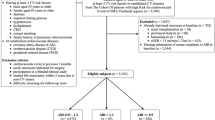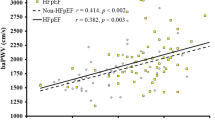Abstract
Background
Increased arterial stiffness is linked to markers of endothelial dysfunction and vasculopathy such as albuminuria, vascular calcification, left ventricular hypertrophy and cardiovascular (CV) diseases. Studies of arterial stiffness on renal progression are limited.
Objective
The study aimed to evaluate the association between high cardio-ankle vascular index (CAVI) and renal endpoint and all-cause mortality in a Thai population with high atherosclerosis risk.
Methods
A multicenter prospective cohort study was conducted among subjects with high CV risk or established CV diseases in Thailand. Subjects were divided into 3 groups with mean CAVI < 8, 8–8.9, and ≥ 9, respectively. Primary composite outcome consisted of estimated glomerular filtration rate (eGFR) decline over 40%, eGFR less than 15 mL/min/1.73 m2, doubling of serum creatinine, initiation of dialysis and death related to renal causes. The secondary outcomes were all-cause mortality, CV mortality and eGFR decline.
Results
A total of 4898 subjects (2743 men and 2155 women) were enrolled. Cox proportional hazards model showed a significant relationship of high CAVI (CAVI ≥ 9) and primary composite outcome. Subjects with high CAVI at baseline had a 1.45-fold (95% CI 1.13–1.84) significant risk for the primary composite outcome and 1.72-fold (95% CI 1.12–2.63) risk for all-cause mortality, compared with normal CAVI (CAVI < 8). After stepwise multivariate analysis, the high CAVI group was only positively associated with primary composite outcome. Kaplan–Meier curve of the primary composite outcome and all-cause mortality demonstrated the worst survival in the high CAVI group (log-rank test with P < 0.05).
Conclusion
In a Thai cohort with high atherosclerosis risk, increased arterial stiffness was a risk factor for worsening renal function, including end-stage renal disease and initiation of dialysis.



Similar content being viewed by others
References
Hidalgo-Santiago JC, Oneto-Otero J, Michan-Dona A, Gomez-Fernandez P. Role of increased central arterial stiffness in macro and microvascular damage in patients with coronary artery disease. Clin Investig Arterioscler. 2021;33(5):224–34.
Fitzpatrick J, Kim ED, Sozio SM, Jaar BG, Estrella MM, Monroy-Trujillo JM, et al. Calcification biomarkers, subclinical vascular disease, and mortality among multiethnic dialysis patients. Kidney Int Rep. 2020;5(10):1729–37.
Alonso-Dominguez R, Sanchez-Aguadero N, Patino-Alonso MC, Agudo-Conde C, de Cabo-Laso A, Gomez-Sanchez M, et al. Association between measurements of arterial stiffness and target organ damage in a general Spanish population. Ann Med. 2021;53(1):345–56.
Kendrick J, Chonchol MB. Nontraditional risk factors for cardiovascular disease in patients with chronic kidney disease. Nat Clin Pract Nephrol. 2008;4(12):672–81.
Dalrymple LS, Katz R, Kestenbaum B, Shlipak MG, Sarnak MJ, Stehman-Breen C, et al. Chronic kidney disease and the risk of end-stage renal disease versus death. J Gen Intern Med. 2011;26(4):379–85.
Petrie JR, Guzik TJ, Touyz RM. Diabetes, hypertension, and cardiovascular disease: clinical insights and vascular mechanisms. Can J Cardiol. 2018;34(5):575–84.
Zhang C, Zhong Y, Tian H. Increased cardio-ankle vascular index is independently associated with chronic kidney disease: a cross-sectional study in Chinese patients with type 2 diabetes mellitus. J Diabetes Complicat. 2019;33(9):623–7.
Li K, Ferguson T, Embil J, Rigatto C, Komenda P, Tangri N. Risk of kidney failure, death, and cardiovascular events after lower limb complications in patients with CKD. Kidney Int Rep. 2021;6(2):381–8.
Satirapoj B, Triwatana W, Supasyndh O. Arterial stiffness predicts rapid decline in glomerular filtration rate among patients with high cardiovascular risks. J Atheroscler Thromb. 2020;27(6):611–9.
Sun CK. Cardio-ankle vascular index (CAVI) as an indicator of arterial stiffness. Integr Blood Press Control. 2013;6:27–38.
Kim KJ, Lee BW, Kim HM, Shin JY, Kang ES, Cha BS, et al. Associations between cardio-ankle vascular index and microvascular complications in type 2 diabetes mellitus patients. J Atheroscler Thromb. 2011;18(4):328–36.
Matsushita K, Ding N, Kim ED, Budoff M, Chirinos JA, Fernhall B, et al. Cardio-ankle vascular index and cardiovascular disease: Systematic review and meta-analysis of prospective and cross-sectional studies. J Clin Hypertens (Greenwich). 2019;21(1):16–24.
Mitchell GF, van Buchem MA, Sigurdsson S, Gotal JD, Jonsdottir MK, Kjartansson O, et al. Arterial stiffness, pressure and flow pulsatility and brain structure and function: the Age gene/environment susceptibility—Reykjavik study. Brain. 2011;134(Pt 11):3398–407.
Fesler P, Safar ME, du Cailar G, Ribstein J, Mimran A. Pulse pressure is an independent determinant of renal function decline during treatment of essential hypertension. J Hypertens. 2007;25(9):1915–20.
Kim ED, Tanaka H, Ballew SH, Sang Y, Heiss G, Coresh J, et al. Associations between kidney disease measures and regional pulse wave velocity in a large community-based cohort: the Atherosclerosis Risk in Communities (ARIC) Study. Am J Kidney Dis. 2018;72(5):682–90.
Alizargar J, Bai CH, Hsieh NC, Wu SV, Weng SY, Wu JP. Association of kidney function tests with a cardio-ankle vascular index in community-dwelling individuals with a normal or mildly decreased estimated glomerular filtration rate. Medicina (Kaunas). 2019;55(10):657.
Jeong JS, Kim JH, Kim DK, Oh KH, Joo KW, Kim YS, et al. Predictive value of cardio-ankle vascular index for the risk of end-stage renal disease. Clin Kidney J. 2021;14(1):255–60.
Namikoshi T, Fujimoto S, Yorimitsu D, Ihoriya C, Fujimoto Y, Komai N, et al. Relationship between vascular function indexes, renal arteriolosclerosis, and renal clinical outcomes in chronic kidney disease. Nephrology (Carlton). 2015;20(9):585–90.
Itano S, Yano Y, Nagasu H, Tomiyama H, Kanegae H, Makino H, et al. Association of arterial stiffness with kidney function among adults without chronic kidney disease. Am J Hypertens. 2020;33(11):1003–10.
Nakamura K, Iizuka T, Takahashi M, Shimizu K, Mikamo H, Nakagami T, et al. Association between cardio-ankle vascular index and serum cystatin C levels in patients with cardiovascular risk factor. J Atheroscler Thromb. 2009;16(4):371–9.
Hitsumoto T. Correlation between the cardio-ankle vascular index and renal resistive index in patients with essential hypertension. Cardiol Res. 2020;11(2):106–12.
Zuo J, Hu Y, Chang G, Chu SL, Tan I, Butlin M, et al. Relationship between arterial stiffness and chronic kidney disease in patients with primary hypertension. J Hum Hypertens. 2020;34(8):577–85.
Kim JM, Kim SS, Kim IJ, Kim JH, Kim BH, Kim MK, et al. Arterial stiffness is an independent predictor for risk of mortality in patients with type 2 diabetes mellitus: the REBOUND study. Cardiovasc Diabetol. 2020;19(1):143.
Heinen Y, Stegemann E, Sansone R, Benedens K, Wagstaff R, Balzer J, et al. Local association between endothelial dysfunction and intimal hyperplasia: relevance in peripheral artery disease. J Am Heart Assoc. 2015;4(2):e001472.
Nowak KL, Jovanovich A, Farmer-Bailey H, Bispham N, Struemph T, Malaczewski M, et al. Vascular dysfunction, oxidative stress, and inflammation in chronic kidney disease. Kidney. 2020;1(6):501–9.
Roumeliotis S, Mallamaci F, Zoccali C. Endothelial dysfunction in chronic kidney disease, from biology to clinical outcomes: a 2020 update. J Clin Med. 2020;9(8):2359.
Lim K, Lu TS, Molostvov G, Lee C, Lam FT, Zehnder D, et al. Vascular Klotho deficiency potentiates the development of human artery calcification and mediates resistance to fibroblast growth factor 23. Circulation. 2012;125(18):2243–55.
Safar ME, Plante GE, Mimran A. Arterial stiffness, pulse pressure, and the kidney. Am J Hypertens. 2015;28(5):561–9.
Kasiske BL. Relationship between vascular disease and age-associated changes in the human kidney. Kidney Int. 1987;31(5):1153–9.
Sequi-Dominguez I, Cavero-Redondo I, Alvarez-Bueno C, Pozuelo-Carrascosa DP, de Arenas-Arroyo SN, Martinez-Vizcaino V. Accuracy of pulse wave velocity predicting cardiovascular and all-cause mortality. A systematic review and meta-analysis. J Clin Med. 2020;9(7):2080.
Acknowledgements
We wish to thank the Heart Association of Thailand under the Royal Patronage of HM the King and the National Research Council of Thailand for databases and data management support. We also acknowledge Ms Sujittra Suriwong for statistical analysis.
Funding
No funding.
Author information
Authors and Affiliations
Contributions
NA and BS reviewed the literature, provided valuable input in designing the study, drafted the article and revised it critically. OS, RK, and AP provided literature review and revised the manuscript critically. All authors read and approved the manuscript and met the criteria for authorship.
Corresponding author
Ethics declarations
Conflict of interest
The authors declare that no potential conflict of interest exists.
Statement of ethics
The study protocol was approved by the Joint Research Ethics Committee and Ministry of Public Health, Thailand. Informed consent was obtained from all patients.
Additional information
Publisher's Note
Springer Nature remains neutral with regard to jurisdictional claims in published maps and institutional affiliations.
About this article
Cite this article
Aiumtrakul, N., Supasyndh, O., Krittayaphong, R. et al. Cardio-ankle vascular index with renal progression and mortality in high atherosclerosis risk: a prospective cohort study in CORE-Thailand. Clin Exp Nephrol 26, 247–256 (2022). https://doi.org/10.1007/s10157-021-02149-x
Received:
Accepted:
Published:
Issue Date:
DOI: https://doi.org/10.1007/s10157-021-02149-x




